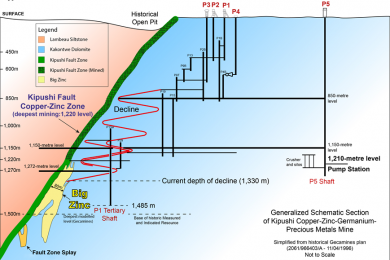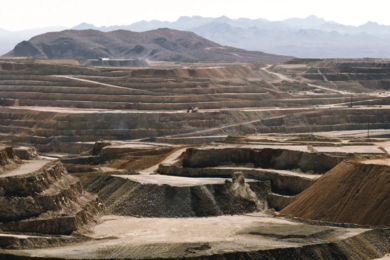Robert Friedland, Executive Chairman of Ivanhoe Mines, and Lars-Eric Johansson, Chief Executive Officer, today announced the positive findings of an independent, pre-feasibility study (PFS) for the planned redevelopment of the company’s historic, high-grade, Kipushi zinc-copper-silver-germanium mine.
The study anticipates annual production of an average of 381,000 t of zinc concentrate over an 11-year initial mine life at a total cash cost of approximately US$0.48 per pound of zinc. The PFS focuses on the initial mining of Kipushi’s Big Zinc Zone, which has an estimated 10.2 Mt of Measured and Indicated Mineral Resources grading 34.9% zinc. The planned return to production would establish Kipushi as the world’s highest-grade major zinc mine. Its exceptional zinc grade is more than twice as high as the Measured and Indicated Mineral Resources of the world’s next-highest-grade zinc project, according to Wood Mackenzie, a leading, international industry research and consulting group. Wood Mackenzie compared the Kipushi Project’s life-of-mine average annual zinc production and zinc head grade of 225,000 t and 32%, respectively, against production and zinc head grade forecasts for 2020.
Given the significant, very-high-grade zinc resource at Kipushi, which is rich in potential by-product credits including copper, silver and germanium and the ongoing exploration campaign at Kipushi, Ivanhoe and the Gécamines technical team are continuing to investigate additional downstream processing options.
“The pre-feasibility study is the latest validation that Kipushi has the resources to become one of the world’s largest and lowest-cost zinc producers, plus the potential to also produce significant quantities of copper, silver and germanium,” said Friedland. “Discussions are continuing with potential strategic partners and lenders to support our continuing advance toward a new era of production at Kipushi. We’ve made significant progress in upgrading the mine’s underground infrastructure and now we have a much clearer path to a resumption of production from this incredibly rich orebody.”
Johansson said that a definitive feasibility study, to further refine and optimise the project’s economics, is underway and is expected to be completed in the second half of 2018. “Since acquiring our 68% interest in the Kipushi Project in 2011, our team has worked closely with our partner, Gécamines, to move the project forward,” he added. “During that time, we’ve seen zinc prices rally from less than US$1.00 per pound to well over US$1.40. We’re confident that the long-term supply and demand fundamentals should support a strong zinc price for a long time to come.”
The Kipushi Project is operated by Kipushi Corporation (KICO),a joint venture between Ivanhoe Mines (68%) and Gécamines (32%), the DRC’s state-owned mining company. Highlights of the PFS, based on a long-term zinc price of US$1.10/lb, include:
- After-tax net present value (NPV) at an 8% real discount rate of US$683 million.
- After-tax real internal rate of return (IRR) of 35.3%.
- After-tax project payback period of 2.2 years.
- Pre-production capital costs, including contingency, estimated at US$337 million.
- Existing surface and underground infrastructure allows for significantly lower capital costs than comparable greenfield development projects.
- Life-of-mine average planned zinc concentrate production of 381,000 dry tonnes per annum, with a concentrate grade of 59% zinc, is expected to rank Kipushi, once in production, among the world’s largest zinc mines.
- Life-of-mine average cash cost of US$0.48/lb of zinc is expected to rank Kipushi, once in production, in the bottom quartile of the cash cost curve for zinc producers globally.










